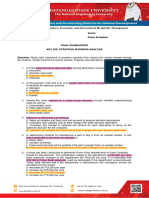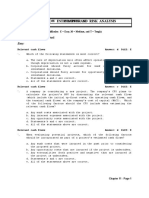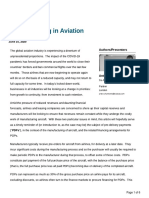0 ratings0% found this document useful (0 votes)
77 viewsCountry Risk Premium
Country Risk Premium
Uploaded by
Sandia EspejoCountry Risk Premium is the additional return investors demand to compensate for higher risk from investing in foreign countries versus domestic markets. It is generally higher for developing than developed nations. Country risk considers factors like political instability, economic risks, sovereign debt, currency fluctuations, and regulations. Estimating CRP involves comparing sovereign debt yields between countries or equity market volatility. The CRP formula uses sovereign bond spreads and equity/bond index volatility to calculate the premium.
Copyright:
© All Rights Reserved
Available Formats
Download as PDF, TXT or read online from Scribd
Country Risk Premium
Country Risk Premium
Uploaded by
Sandia Espejo0 ratings0% found this document useful (0 votes)
77 views3 pagesCountry Risk Premium is the additional return investors demand to compensate for higher risk from investing in foreign countries versus domestic markets. It is generally higher for developing than developed nations. Country risk considers factors like political instability, economic risks, sovereign debt, currency fluctuations, and regulations. Estimating CRP involves comparing sovereign debt yields between countries or equity market volatility. The CRP formula uses sovereign bond spreads and equity/bond index volatility to calculate the premium.
Original Description:
Country Risk premium is the additional
Original Title
Country Risk Premium_07f6fdc88eafa1cc6f1e174e37422aa0
Copyright
© © All Rights Reserved
Available Formats
PDF, TXT or read online from Scribd
Share this document
Did you find this document useful?
Is this content inappropriate?
Country Risk Premium is the additional return investors demand to compensate for higher risk from investing in foreign countries versus domestic markets. It is generally higher for developing than developed nations. Country risk considers factors like political instability, economic risks, sovereign debt, currency fluctuations, and regulations. Estimating CRP involves comparing sovereign debt yields between countries or equity market volatility. The CRP formula uses sovereign bond spreads and equity/bond index volatility to calculate the premium.
Copyright:
© All Rights Reserved
Available Formats
Download as PDF, TXT or read online from Scribd
Download as pdf or txt
0 ratings0% found this document useful (0 votes)
77 views3 pagesCountry Risk Premium
Country Risk Premium
Uploaded by
Sandia EspejoCountry Risk Premium is the additional return investors demand to compensate for higher risk from investing in foreign countries versus domestic markets. It is generally higher for developing than developed nations. Country risk considers factors like political instability, economic risks, sovereign debt, currency fluctuations, and regulations. Estimating CRP involves comparing sovereign debt yields between countries or equity market volatility. The CRP formula uses sovereign bond spreads and equity/bond index volatility to calculate the premium.
Copyright:
© All Rights Reserved
Available Formats
Download as PDF, TXT or read online from Scribd
Download as pdf or txt
You are on page 1of 3
COUNTRY RISK PREMIUM
Descriptions about Country Risk Premium
It is the additional return or premium demanded by investors to compensate them
for the higher risk associated with investing in a foreign country, compared with
investing in the domestic market.
It is generally higher for developing markets than for developed nations.
Understanding Country Risk Premium (CRP)
Country risk encompasses numerous factors, including:
- Political instability;
- Economic risks such as recessionary conditions, higher inflation etc.;
- Sovereign debt burden and default probability;
- Currency fluctuations;
- Adverse government regulations (such as expropriation or currency controls).
Country risk is a key factor to be considered when investing in foreign markets. Most
national export development agencies have in-depth dossiers on the risks associated
with doing business in various countries around the world.
Country Risk Premium can have a significant impact on valuation and corporate
finance calculations. The calculation of CRP involves estimating the risk premium for
a mature market such as the United States, and adding a default spread to it.
Estimating Country Risk Premium
1. Sovereign Debt Method: CRP for a particular country can be estimated by comparing
the spread on sovereign debt yields between the country and a mature market like
the U.S.
2. Equity Risk Method: CRP is measured on the basis of the relative volatility of equity
market returns between a specific country and a developed nation.
Factors to consider while estimating Country risk premium
Macroeconomic factors like inflation
Currency fluctuations
Fiscal deficit and related policies
Country Risk Premium Formula
CRP = Spread on Sovereign Bond Yield * (Risk Estimate on Equity Index Annualized /
Risk Estimate on Bond Index Annualized)
Thus, more technically,
CRP = Spread on Sovereign Bond Yield * Annualized Standard Deviation on Equity
Index / Annualized Standard Deviation on Bond Index
Example 1: If a country has an annualized return of 18% and 12.5% on equity and
bond index, respectively, over a 5-year period, what is the country risk premium?
The country’s treasury bond has yielded a 3.5% return, whereas sovereign bond has
a 7% yield on a similar period.
Example 2: Calculate the CRP with similar yields as in the example above, other than
the equity index yield, which is 21%.
Notice that as the equity index yield goes up from 18% to 21%, the CRP increases
from 5.04% to 5.88%. This can be attributed to the higher volatility in the equity
market, which has produced a higher return and hence raises the CRP with it.
Country Risk Premium Calculation & CAPM
Country risk premium finds most use in the CAPM (Capital Asset Pricing Model)
theory. A CAPM model is a measure of return on equity considering the non-
systematic risk or firm risk where,
Re = Rf + β x (Rm-Rf)
Re is the return on equity,
Rf is the risk-free rate,
Β is the Beta or market risk, and
Rm is return expected from the market.
Approaches to estimate Rebased on the inclusion of CRP.
1. One way to include country risk premium (CRP) is to add it to the risk-free and
risky asset component. Hence, Re = Rf + β x (Rm-Rf) + CRP
2. Another way to include CRP in the CAPM model is to make it a function of firm
risk. Re = Rf + β x (Rm-Rf + CRP)
- Approach 1 differs from 2 in that Country risk is unconditional addition to every
firm’s risk-return profile.
- Example 3: Calculate the return on equity from the following information:
Risk-Free Rate (Rf): 4%
Expected Market Return (Rm): 8%
Firm Beta (β): 1.2
Country Risk Premium: 5.2%
You might also like
- Speak Fast EnglishDocument3 pagesSpeak Fast EnglishSandia Espejo100% (1)
- Review For Exam 1Document18 pagesReview For Exam 1Alva CaldwellNo ratings yet
- Part 1: Financial ForecastingDocument8 pagesPart 1: Financial ForecastingJustine CruzNo ratings yet
- Capital Budgeting Techniques: Multiple Choice QuestionsDocument10 pagesCapital Budgeting Techniques: Multiple Choice QuestionsRod100% (1)
- Equity QUIZDocument8 pagesEquity QUIZSaYeD SeeDooNo ratings yet
- Tutorial 1Document2 pagesTutorial 1musicslave96No ratings yet
- S1 S2 P1 P2 S1 0.20 0.60 0.30 S2 0.10 0.40 0.50Document111 pagesS1 S2 P1 P2 S1 0.20 0.60 0.30 S2 0.10 0.40 0.50Navindra JaggernauthNo ratings yet
- ACC 308 Multiple Choice QuestionsDocument18 pagesACC 308 Multiple Choice QuestionsAceain SoNo ratings yet
- ECON 24 QUIZ 6 CHAPTER 8 Answered To Be Double CheckedDocument13 pagesECON 24 QUIZ 6 CHAPTER 8 Answered To Be Double CheckedDanrey PasiliaoNo ratings yet
- (6-2) Interest Rate Levels CH Answer: B MEDIUMDocument9 pages(6-2) Interest Rate Levels CH Answer: B MEDIUMMohsin2k100% (1)
- Quantitative MethodsDocument19 pagesQuantitative MethodsAlvin DantesNo ratings yet
- HO No. 1 - Risks, Returns and Capital StructureDocument3 pagesHO No. 1 - Risks, Returns and Capital StructureNath NathNo ratings yet
- ch18 - Percentage CompletionDocument49 pagesch18 - Percentage CompletionFrost MintNo ratings yet
- Chap 017Document36 pagesChap 017yusraNo ratings yet
- PRELEC1 Final ExamDocument4 pagesPRELEC1 Final ExamAramina Cabigting BocNo ratings yet
- Final PreBoard Examination MASDocument9 pagesFinal PreBoard Examination MASErina AusriaNo ratings yet
- MULTIPLE CHOICE - Capital BudgetingDocument9 pagesMULTIPLE CHOICE - Capital BudgetingMarcuz AizenNo ratings yet
- Acctg201 QuizDocument4 pagesAcctg201 QuizJehny AbelgasNo ratings yet
- Financial Management - Part 1 For PrintingDocument13 pagesFinancial Management - Part 1 For PrintingKimberly Pilapil MaragañasNo ratings yet
- ACCTG 105 Midterm - Quiz No. 02 - Accounting Changes and Errors (Answers)Document2 pagesACCTG 105 Midterm - Quiz No. 02 - Accounting Changes and Errors (Answers)Lucas BantilingNo ratings yet
- Cost Accounting Chapter 11 QuizDocument3 pagesCost Accounting Chapter 11 Quizzeel801No ratings yet
- Review Handouts and Materials: Semester First Semester School Year 2019-2020 Subject Handout # TopicDocument34 pagesReview Handouts and Materials: Semester First Semester School Year 2019-2020 Subject Handout # TopicWilson TanNo ratings yet
- Reviewer Incremental Analysis 1Document5 pagesReviewer Incremental Analysis 1Shaira Rehj RiveraNo ratings yet
- Afa-Ii CH-1Document35 pagesAfa-Ii CH-1Benol MekonnenNo ratings yet
- Studet Practical Accounting Ch17 PPE AcquisitionDocument16 pagesStudet Practical Accounting Ch17 PPE Acquisitionsabina del monteNo ratings yet
- Quiz 1Document6 pagesQuiz 1Jonathan VidarNo ratings yet
- Fringe Benefit - QuizDocument3 pagesFringe Benefit - QuizArlea AsenciNo ratings yet
- IFRS 15 Practice QuestionsDocument1 pageIFRS 15 Practice Questionskoketso100% (1)
- Responsibility Acctg Transfer Pricing GP AnalysisDocument21 pagesResponsibility Acctg Transfer Pricing GP AnalysisMoon LightNo ratings yet
- Cash Flow Estimation BrighamDocument77 pagesCash Flow Estimation BrighamDianne GalarosaNo ratings yet
- Exam 3 TestbankDocument76 pagesExam 3 Testbankpauline leNo ratings yet
- CONCEPTUAL FRAMEWORK HandoutDocument6 pagesCONCEPTUAL FRAMEWORK HandoutRuby RomeroNo ratings yet
- Assignment - Intangible AssetDocument5 pagesAssignment - Intangible AssetJane DizonNo ratings yet
- Module 4Document14 pagesModule 4Queenie ValleNo ratings yet
- Chapter 11-Raising Long-Term Financing: Multiple ChoiceDocument18 pagesChapter 11-Raising Long-Term Financing: Multiple ChoiceEuxine AlbisNo ratings yet
- P2 Business Combination - GuerreroDocument18 pagesP2 Business Combination - GuerreroCelen OchocoNo ratings yet
- Quiz 2 CapbudDocument5 pagesQuiz 2 Capbudbrmo.amatorio.uiNo ratings yet
- Mockboard (Mas)Document3 pagesMockboard (Mas)Nezhreen MaruhomNo ratings yet
- Review 105 - Day 4 Theory of AccountsDocument13 pagesReview 105 - Day 4 Theory of Accountschristine anglaNo ratings yet
- PAS 02 InventoriesDocument3 pagesPAS 02 InventoriesRia GayleNo ratings yet
- Quiz4-Responsibilityacctg TP BalscoreDocument5 pagesQuiz4-Responsibilityacctg TP BalscoreRambell John RodriguezNo ratings yet
- A1-2BSA-01 P3 QuizDocument7 pagesA1-2BSA-01 P3 QuizBea EuniceNo ratings yet
- AFAR Exam Midterms 1Document4 pagesAFAR Exam Midterms 1CJ Hernandez Borreta100% (1)
- Chapter 10 The Mortgage Markets and DerivativesDocument25 pagesChapter 10 The Mortgage Markets and DerivativesKena Montes Dela PeñaNo ratings yet
- Accounting Principles: Corporations: Dividends, Retained Earnings, and Income ReportingDocument55 pagesAccounting Principles: Corporations: Dividends, Retained Earnings, and Income ReportingWadood AhmedNo ratings yet
- Deductions From Gross IncomeDocument10 pagesDeductions From Gross IncomewezaNo ratings yet
- N. Cruz-Course Material For Strategic Cost ManagementDocument134 pagesN. Cruz-Course Material For Strategic Cost ManagementEmmanuel VillafuerteNo ratings yet
- Capital BudgetingggDocument73 pagesCapital Budgetingggjeremy nicoleNo ratings yet
- At.2506 Determining MaterialityDocument26 pagesAt.2506 Determining Materialityawesome bloggersNo ratings yet
- This Study Resource Was: SolutionDocument1 pageThis Study Resource Was: SolutionChristine Joy OriginalNo ratings yet
- BAC 112 Final Examination With QuestionsDocument10 pagesBAC 112 Final Examination With Questionsjanus lopezNo ratings yet
- True or False: Multiple Choice QuestionsDocument7 pagesTrue or False: Multiple Choice QuestionsDetox FactorNo ratings yet
- An Introduction To Consolidated Financial Statements LO1: Chapter 3 Test BankDocument32 pagesAn Introduction To Consolidated Financial Statements LO1: Chapter 3 Test BankKaren MagsayoNo ratings yet
- RFBT Final Preboard 94 QuestionnaireDocument16 pagesRFBT Final Preboard 94 QuestionnaireJunmar AMITNo ratings yet
- Cpa Review School of The Philippines Manila Management Advisory Services Working Capital FinanceDocument11 pagesCpa Review School of The Philippines Manila Management Advisory Services Working Capital FinancezenvioNo ratings yet
- Seatwork 01 Financial Statement Analysis PDFDocument5 pagesSeatwork 01 Financial Statement Analysis PDFHannah Mae VestilNo ratings yet
- MAC Material 2Document33 pagesMAC Material 2Blessy Zedlav LacbainNo ratings yet
- R04 Capital Market Expectations, Part 2 - Forecasting Asset Class Returns HY NotesDocument7 pagesR04 Capital Market Expectations, Part 2 - Forecasting Asset Class Returns HY NotesArcadioNo ratings yet
- ACC 222 - Risk, Rates of Return and Cost of CapitalDocument11 pagesACC 222 - Risk, Rates of Return and Cost of CapitalJesiah PascualNo ratings yet
- Capital Asset Pricing ModelDocument6 pagesCapital Asset Pricing ModelkelvinramosNo ratings yet
- RFR CapmDocument23 pagesRFR CapmAline Aprille Capuchino MendezNo ratings yet
- Financial Modeling ActivitiesDocument1,106 pagesFinancial Modeling ActivitiesSandia EspejoNo ratings yet
- Screening Capital Investment ProposalsDocument13 pagesScreening Capital Investment ProposalsSandia EspejoNo ratings yet
- Revenues From Contracts With CustomersDocument8 pagesRevenues From Contracts With CustomersSandia EspejoNo ratings yet
- Offshore Banking UnitDocument3 pagesOffshore Banking UnitSandia EspejoNo ratings yet
- Change in Accounting PolicyDocument5 pagesChange in Accounting PolicySandia EspejoNo ratings yet
- Theories of International Trade and Investment-1Document11 pagesTheories of International Trade and Investment-1Sandia EspejoNo ratings yet
- IV.-Equity-Market-Securities LessonDocument4 pagesIV.-Equity-Market-Securities LessonSandia EspejoNo ratings yet
- Life's Work of RizalDocument11 pagesLife's Work of RizalSandia EspejoNo ratings yet
- Optional Standard Deductions ExampleDocument7 pagesOptional Standard Deductions ExampleSandia EspejoNo ratings yet
- Life of RizalDocument16 pagesLife of RizalSandia EspejoNo ratings yet
- Commercial PapersDocument3 pagesCommercial PapersSandia EspejoNo ratings yet
- College of Human Kinetics: Cagayan State UniversityDocument9 pagesCollege of Human Kinetics: Cagayan State UniversitySandia EspejoNo ratings yet
- Special Allowable Itemized DeductionsDocument13 pagesSpecial Allowable Itemized DeductionsSandia EspejoNo ratings yet
- Descriptions of Repurchase Agreement (Repo)Document1 pageDescriptions of Repurchase Agreement (Repo)Sandia EspejoNo ratings yet
- Lesson 6Document22 pagesLesson 6Sandia EspejoNo ratings yet
- Practice Questions For Exam III (Time Value of Money and Valuation and Rates of Return)Document25 pagesPractice Questions For Exam III (Time Value of Money and Valuation and Rates of Return)Kim FloresNo ratings yet
- By SP TulsianDocument4 pagesBy SP TulsianSwetha Rakesh AdigaNo ratings yet
- Proposed IIM Indore Alumni Angel Fund 2Document8 pagesProposed IIM Indore Alumni Angel Fund 2navin_iNo ratings yet
- Ifm PresentationDocument37 pagesIfm PresentationamreenaNo ratings yet
- Cost of Capital PPT at Bec Doms On FinanceDocument44 pagesCost of Capital PPT at Bec Doms On FinanceBabasab Patil (Karrisatte)No ratings yet
- Crude Oil January 2021 Contract OnwardsDocument2 pagesCrude Oil January 2021 Contract OnwardsAshish SinghNo ratings yet
- Over-Optimism When Pricing Ipos: MF 33,6 Stefano Paleari and Silvio VismaraDocument16 pagesOver-Optimism When Pricing Ipos: MF 33,6 Stefano Paleari and Silvio VismaraPranav ShandilNo ratings yet
- Unit-3 Capital BudgetingDocument83 pagesUnit-3 Capital BudgetingAashutosh MishraNo ratings yet
- Executive SummaryDocument41 pagesExecutive SummaryAnonymous CgJjQiCu5ANo ratings yet
- 10K OCIO Framework August 2021Document11 pages10K OCIO Framework August 2021Shashi TiwariNo ratings yet
- Main Financial Performance Analysis of Dhaka Bank Limited-Converted 02.02.2020Document45 pagesMain Financial Performance Analysis of Dhaka Bank Limited-Converted 02.02.2020ABC Computer R.SNo ratings yet
- Lu Bba SyllabusDocument10 pagesLu Bba SyllabusTalha SiddiquiNo ratings yet
- Real Estate ValuationDocument21 pagesReal Estate Valuationjoekamunya63No ratings yet
- Cyril-Baudrillart PNFDocument59 pagesCyril-Baudrillart PNFJohn MNo ratings yet
- Unit 4: Relative ValuationDocument47 pagesUnit 4: Relative ValuationMadhvendra BhardwajNo ratings yet
- Chap 016Document50 pagesChap 016Amit Jindal100% (2)
- SELCODocument13 pagesSELCOEnergy for AllNo ratings yet
- Financial Statements Analysis and Long-Term Planning: Mcgraw-Hill/IrwinDocument31 pagesFinancial Statements Analysis and Long-Term Planning: Mcgraw-Hill/Irwindaisuke_kazukiNo ratings yet
- MCQs For National Savings Officers PostsDocument8 pagesMCQs For National Savings Officers PostsKhizar Khan Jiskani100% (2)
- Functions and Legal Fram Work of Stock Exchange: (Going On The Right Track)Document42 pagesFunctions and Legal Fram Work of Stock Exchange: (Going On The Right Track)Rahul SoganiNo ratings yet
- Kel 09 - Pengaruh Struktur Modal Terhadap Profitabilitas PerusahaanDocument60 pagesKel 09 - Pengaruh Struktur Modal Terhadap Profitabilitas PerusahaanIhsan Faizal MalikNo ratings yet
- Loyalty Based Management (The Loyalty Effect)Document21 pagesLoyalty Based Management (The Loyalty Effect)sireeshaNo ratings yet
- BOC - WorkshopDocument21 pagesBOC - WorkshopVedanth MudholkarNo ratings yet
- Module 2B - Partnership Student HandoutDocument4 pagesModule 2B - Partnership Student HandoutShivaraj PatilNo ratings yet
- PDP - Financing in AviationDocument6 pagesPDP - Financing in AviationCarlos E. BanegasNo ratings yet
- NPV IrrDocument6 pagesNPV IrrDiana BlueseaNo ratings yet
- Problems On Bond YieldDocument3 pagesProblems On Bond YieldPersonal DocumentsNo ratings yet
- Business PlanDocument20 pagesBusiness PlanMarvin Bueno100% (2)
- Sensex Hits 16,000 The India Street Special ReportDocument7 pagesSensex Hits 16,000 The India Street Special ReportMark Fidelman100% (3)
- A.2. Investments and Long-Term AssetsDocument48 pagesA.2. Investments and Long-Term AssetsKondreddi SakuNo ratings yet









































































































